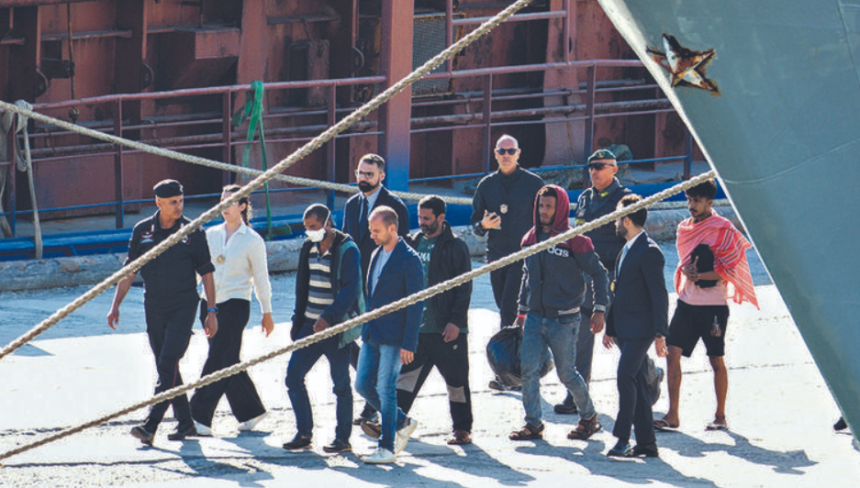The arrival of the first migrants in Albania under a newly signed agreement with Italy has sparked widespread controversy and debate within both countries. This deal, intended to address the escalating migration crisis in Europe, marks a significant shift in how migrants are processed and housed. While proponents argue that it provides a practical solution to alleviate pressure on Italy’s overcrowded facilities, critics claim that it poses serious risks, both to the migrants themselves and to Albania’s political, social, and economic fabric.
This article examines the details of the migration agreement between Italy and Albania, explores the circumstances surrounding the first group of migrants’ arrival, and evaluates the potential ramifications for both countries and for European migration policy more broadly.
1. The Italy-Albania Migration Deal: Background and Intent
1.1 Motivation Behind the Deal
Italy has been struggling to cope with the overwhelming number of migrants arriving on its shores in recent years, particularly through the Mediterranean route. In 2023 alone, the country saw tens of thousands of asylum seekers land on its coasts, mainly from North Africa, the Middle East, and Sub-Saharan Africa. Italian reception centers, especially on the island of Lampedusa and in Sicily, have been pushed beyond their limits, with overcrowding leading to deteriorating living conditions for migrants and logistical challenges for the authorities.
The Italian government, led by Prime Minister Giorgia Meloni, sought a solution to ease the strain on its infrastructure, while still maintaining control over migration flows. In response, Italy signed a controversial deal with Albania in mid-2024, allowing some migrants to be temporarily housed in Albania while their asylum claims are processed. The agreement is seen as part of a broader effort by Italy to outsource parts of its migration management system, a strategy that has drawn comparisons to other deals made between the European Union and countries like Turkey and Libya in recent years.
1.2 Key Provisions of the Agreement
The Italy-Albania migration deal includes several provisions designed to manage the flow of migrants between the two nations:
- Temporary Relocation: Under the agreement, migrants arriving in Italy can be temporarily relocated to Albania, where they will be housed in designated reception centers.
- Asylum Processing: Migrants sent to Albania will have their asylum claims processed by Italian authorities in collaboration with Albanian officials. Successful applicants will be granted asylum in Italy or relocated to another EU country, while those whose claims are rejected may face deportation.
- Financial Compensation: Italy has agreed to provide financial assistance to Albania to help manage the increased burden of housing and processing migrants. This includes funding for the construction of new reception centers, as well as economic incentives aimed at supporting Albania’s local infrastructure and services.
- Duration and Scale: The deal is set to last for an initial period of five years, with the possibility of extension. While the exact number of migrants involved has not been disclosed, it is expected that thousands will be sent to Albania as Italy seeks to relieve pressure on its own system.
2. First Migrants Arrive: A Tense and Uncertain Start
2.1 The Arrival
The first group of migrants arrived in Albania in early October 2024, marking the official implementation of the agreement. These migrants, predominantly from African and Middle Eastern countries, were flown from overcrowded reception centers in Italy to a newly constructed facility near the Albanian capital, Tirana.
The group consisted of approximately 300 men, women, and children, most of whom had been waiting for their asylum claims to be processed in Italy for several months. Upon arrival, they were taken to the reception center, where they were provided with basic amenities such as food, shelter, and medical care.
2.2 Reactions from Albania and Italy
The arrival of the migrants has been met with mixed reactions in both countries. In Albania, there has been a significant public outcry, with protests erupting in Tirana and other cities. Many Albanians fear that their country, which has its own economic struggles and high levels of unemployment, is not equipped to handle the influx of migrants. Some view the deal as a threat to Albania’s national sovereignty, while others argue that it could strain public services and lead to social tensions.
In Italy, the response has been similarly divided. Supporters of the deal, particularly within the Italian government, see it as a pragmatic solution to reduce the burden on Italy’s reception centers. Prime Minister Giorgia Meloni defended the deal as necessary to protect Italy’s security and uphold its migration policies. However, opposition parties and human rights groups have criticized the agreement, arguing that it simply shifts Italy’s migration problem onto a poorer country and may violate international human rights standards.
3. Human Rights Concerns and Legal Challenges
3.1 Potential Violations of International Law
One of the most contentious aspects of the Italy-Albania migration deal is the question of whether it complies with international human rights law. Critics, including several prominent NGOs and human rights organizations, argue that relocating migrants to Albania may breach the 1951 Refugee Convention, which guarantees the right to seek asylum in the country of first arrival.
There are concerns that Albania, which is not an EU member state, may not have the necessary legal framework or resources to adequately process asylum claims in accordance with international standards. Furthermore, questions have been raised about whether migrants sent to Albania will have access to fair and transparent legal processes, as well as adequate protection from deportation to countries where they may face persecution.
3.2 Conditions in Albanian Reception Centers
Another major concern is the conditions in the reception centers where migrants will be housed. While Italy has pledged to provide financial support to improve Albania’s facilities, there are fears that the centers may become overcrowded and under-resourced, mirroring the situation in Italy. Reports from human rights groups have highlighted the risk of inadequate healthcare, poor sanitation, and limited access to education and employment opportunities for migrants in Albania.
The Albanian government has sought to reassure the international community that it will ensure humane conditions for the migrants and work closely with Italian authorities to uphold their rights. However, skepticism remains, particularly given Albania’s own economic challenges and its limited experience in managing large numbers of asylum seekers.
4. Political Fallout: Domestic and International Repercussions
4.1 Impact on Albanian Politics
The deal has become a highly divisive issue in Albanian politics. Prime Minister Edi Rama, who negotiated the agreement with Italy, has defended the deal as an opportunity for Albania to strengthen its ties with Italy and the European Union. He also emphasized the financial benefits that Albania will receive as part of the arrangement, arguing that it could help boost the country’s economy.
However, opposition parties and nationalist groups in Albania have fiercely opposed the deal, accusing the government of selling out the country’s sovereignty for financial gain. They argue that Albania should not be used as a dumping ground for Italy’s migration problems and warn that the deal could lead to increased social unrest and tension within the country.
4.2 Reactions from the European Union
The Italy-Albania deal has also drawn reactions from other European countries and the EU itself. Some EU member states have expressed concern that the deal sets a dangerous precedent, potentially leading to more countries outsourcing their migration responsibilities to non-EU nations. Others have praised Italy for taking steps to address its migration crisis while maintaining control over its borders.
The European Commission has remained relatively neutral on the issue, stating that it will monitor the situation closely to ensure that the rights of migrants are upheld and that Albania complies with international obligations. However, the deal raises broader questions about the future of migration policy in Europe and the extent to which EU countries are willing to collaborate with non-member states on managing migration flows.
5. The Future of the Italy-Albania Migration Deal
5.1 Challenges Ahead
As the Italy-Albania migration deal enters its initial phase, several key challenges loom on the horizon. The first and most immediate challenge will be ensuring that the reception centers in Albania are adequately equipped to handle the influx of migrants and that the asylum process remains fair and transparent.
Another challenge will be managing the political and social fallout in Albania, where public opposition to the deal is growing. The Albanian government will need to navigate these tensions carefully to avoid unrest and maintain public confidence in its ability to manage the situation.
5.2 Long-Term Implications for Migration Policy
The Italy-Albania deal may have far-reaching implications for migration policy in Europe. If the agreement proves successful, it could serve as a model for other countries facing migration pressures, potentially leading to more partnerships between EU countries and their neighbors. However, if the deal results in human rights violations or social unrest, it could backfire, leading to further political instability and damaging Albania’s relations with Italy and the EU.
In the long term, the deal raises important questions about the responsibility of European nations to manage migration flows and protect the rights of asylum seekers. As Europe continues to grapple with the challenges of migration, the Italy-Albania agreement will be closely watched as a test case for new approaches to migration management.
6. Conclusion: A Controversial Solution to a Complex Crisis
The arrival of the first migrants in Albania under the Italy-Albania migration deal marks the beginning of a new and controversial chapter in European migration policy. While the deal offers a temporary solution to Italy’s overcrowded reception centers, it raises significant legal, ethical, and political concerns that will need to be addressed in the coming months and years.
As Albania and Italy navigate the complexities of this agreement, the eyes of the international community will be watching closely. The ultimate success or failure of the deal will depend on both countries’ ability to uphold the rights of migrants, manage the political fallout, and ensure that this controversial solution does not lead to further instability in an already fragile region. ALSO READ:-Tragedy in Nigeria: Over 140 Killed Following Devastating Fuel Tanker Explosion





